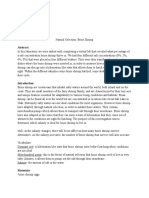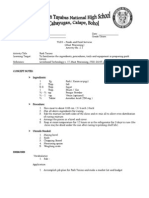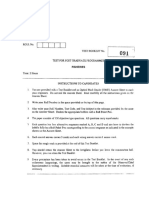Professional Documents
Culture Documents
1 - Shark Key and Question Answers
1 - Shark Key and Question Answers
Uploaded by
Armani WattsOriginal Description:
Original Title
Copyright
Available Formats
Share this document
Did you find this document useful?
Is this content inappropriate?
Report this DocumentCopyright:
Available Formats
1 - Shark Key and Question Answers
1 - Shark Key and Question Answers
Uploaded by
Armani WattsCopyright:
Available Formats
SHARK TAXONOMIC KEY ANSWERS
(For ease of grading, I have removed the instructive parts of the lab from the key)
1. Rajidae
2. Alopidae
3. Pristiophoridae
4. Carcharhinidae
5. Scyliorhinidae
6. Rhinocodonididae
7. Isuridae
8. Squalidae
9. Dasyatidae
10. Scapanohynchidae
11. Pseudotriakidae
12. Hexanchidae
13. Sphyrinidae
14. Mobulidae
1. As you worked down the dichotomous classification key to identify sharks, did you go from
general to specific characteristics or from specific to general characteristics? Explain your
answer using four characteristics that were used in the shark key.
You should be going from general to specific characteristics. Many sharks look alike, but some
of very distinctive features. Removing those from your options will allow you to examine
specific details that separate one group from another. Four characteristics that should be used
include body shape, body appendages, gill number, and various fin conditions (presence of, size,
length, etc.).
2. Which main characteristics could be used to distinguish shark 4 from shark 8?
The main difference between sharks 4 and 8 was is that shark 4 (Carcharhinidae) has an anal fin,
whereas shark 8 (Squalidae) does not.
3. Which main characteristic could be used to distinguish shark 4 from shark 7?
The main difference between sharks 4 and 7 was that shark 4 (Carcharhinidae) has a caudal fin
where the top half is different in shape and size from the bottom half whereas shark 7 (Isuridae)
has a caudal fin that is nearly the same size on both lobes.
4. What taxons (classification levels) are represented by the scientific name of an organism?
What are the rules for writing a binomial name?
The family level of taxonomic nomenclature is what is given here. An individual species is
identified using a binomial name consisting of the genus and the species names. The genus is the
most recent ancestors and the species is that organism’s individual identifying name. Think of it
in terms of your name. Your last name would be the genus (your most recent ancestor) and your
first name being the species name (your individual identifier). A binomial name should have the
genus capitalized, while the species name is not. Both names should be in italics if you are
typing them or underlined if you are writing them out by hand.
5. Why do biological classification keys always present only two choices at each step?
This simplifies the options available for identification. A key that is unnecessarily complex can
create confusion and potentially result in misidentification of a species.
You might also like
- 3.09 Lab - Cell Shape and Size 1Document2 pages3.09 Lab - Cell Shape and Size 1ivanaNo ratings yet
- Niche PartitioningDocument3 pagesNiche PartitioningKhang LqNo ratings yet
- Nesters Microbiology A Human PerspectiveDocument31 pagesNesters Microbiology A Human PerspectiveDevin MckayNo ratings yet
- Day 4. Warm-Up. STAAR® Blitz. Science. BiologyDocument2 pagesDay 4. Warm-Up. STAAR® Blitz. Science. BiologyRaul Ramirez RangelNo ratings yet
- Regulation - Lactase - Gene - Click - Learn - WorksheetDocument3 pagesRegulation - Lactase - Gene - Click - Learn - WorksheetSophia BrannemanNo ratings yet
- Population Evolution, Genetic Drift, Hardy-Weinberg WebquestDocument8 pagesPopulation Evolution, Genetic Drift, Hardy-Weinberg WebquestLucas NavarroNo ratings yet
- Phylogeny Review Worksheet 2017Document6 pagesPhylogeny Review Worksheet 2017Andevie Balili IguanaNo ratings yet
- Brine Shrimp Lab Write UpDocument6 pagesBrine Shrimp Lab Write Upapi-612419914No ratings yet
- Investigation: Meiosis in Sordaria: Life Cycle of SordariaDocument5 pagesInvestigation: Meiosis in Sordaria: Life Cycle of SordariasydneyNo ratings yet
- Charles Darwin Web Quest AnswersDocument3 pagesCharles Darwin Web Quest AnswersKeyshawnNo ratings yet
- 1st Year Chapter 1 Biology Book Fed BoardDocument86 pages1st Year Chapter 1 Biology Book Fed Boardwondersofworld.30No ratings yet
- Temperature-Responsive Polymers: Chemistry, Properties, and ApplicationsFrom EverandTemperature-Responsive Polymers: Chemistry, Properties, and ApplicationsNo ratings yet
- BIOLOGICAL CONTROL OF Marmara Gulosa GUILLÉN AND DAVIS IN THE SANDocument196 pagesBIOLOGICAL CONTROL OF Marmara Gulosa GUILLÉN AND DAVIS IN THE SANAnanthSivapunniyam100% (1)
- Minnesota Hospital Association's Lown Institute ResponseDocument3 pagesMinnesota Hospital Association's Lown Institute ResponseinforumdocsNo ratings yet
- Pest Ex 3 & 4Document15 pagesPest Ex 3 & 4Kiruba KaranNo ratings yet
- Case Study - Invading Bullfrogs Part 1: What's in The Pond?: High MountainsDocument4 pagesCase Study - Invading Bullfrogs Part 1: What's in The Pond?: High Mountainsalissa arnoldNo ratings yet
- Environmental Preservation and the Grey Cliffs Conflict: Negotiating Common Narratives, Values, and EthosFrom EverandEnvironmental Preservation and the Grey Cliffs Conflict: Negotiating Common Narratives, Values, and EthosNo ratings yet
- Cell (Biology) : Navigation SearchDocument14 pagesCell (Biology) : Navigation Searchsamz95100% (1)
- ASPB - The Arabidopsis Book PDFDocument1,239 pagesASPB - The Arabidopsis Book PDFGabyMezaCarrascoNo ratings yet
- CMB Lab Exp 9Document9 pagesCMB Lab Exp 9Elizabeth Jade ViceraNo ratings yet
- Bio102 General Biology II SummaryDocument47 pagesBio102 General Biology II SummaryIkenna Okpala100% (1)
- Cell (Biology) : Cells in Different Phases of The Cell CycleDocument14 pagesCell (Biology) : Cells in Different Phases of The Cell CycleroavNo ratings yet
- Functional and Physical Properties of Polymer NanocompositesFrom EverandFunctional and Physical Properties of Polymer NanocompositesAravind DasariNo ratings yet
- Isolation and Characterization of Fungi Associated With Spoiled TomatoesDocument5 pagesIsolation and Characterization of Fungi Associated With Spoiled TomatoesJimoh Jamal100% (1)
- Biopolymers: New Materials for Sustainable Films and CoatingsFrom EverandBiopolymers: New Materials for Sustainable Films and CoatingsDavid PlackettNo ratings yet
- Guide for Monitoring and Evaluation of the Public Agricultural Extension and Advisory Service SystemFrom EverandGuide for Monitoring and Evaluation of the Public Agricultural Extension and Advisory Service SystemNo ratings yet
- Synthetic Natural Gas: From Coal, Dry Biomass, and Power-to-Gas ApplicationsFrom EverandSynthetic Natural Gas: From Coal, Dry Biomass, and Power-to-Gas ApplicationsTilman J. SchildhauerNo ratings yet
- Mishra Shashi IndianJournalofEcology 114 119Document7 pagesMishra Shashi IndianJournalofEcology 114 119bharath ugNo ratings yet
- Nanoparticulate Drug Delivery Systems: Strategies, Technologies, and ApplicationsFrom EverandNanoparticulate Drug Delivery Systems: Strategies, Technologies, and ApplicationsYoon YeoNo ratings yet
- Distribution of Thysanoptera Species and Their Host Plants in CroatiaDocument9 pagesDistribution of Thysanoptera Species and Their Host Plants in CroatiaDragan ItakoToNo ratings yet
- Advances in Physicochemical Properties of Biopolymers: Part 2From EverandAdvances in Physicochemical Properties of Biopolymers: Part 2No ratings yet
- Cellular Basis of HeredityDocument12 pagesCellular Basis of HeredityLadyvirdi CarbonellNo ratings yet
- Nanotechnology: An Introduction to Nanostructuring TechniquesFrom EverandNanotechnology: An Introduction to Nanostructuring TechniquesNo ratings yet
- Dichotomous Key PracticeDocument2 pagesDichotomous Key PracticeBioScMentor-1No ratings yet
- BIO301 Handouts 1 167Document351 pagesBIO301 Handouts 1 167Tayyaba ArbabNo ratings yet
- p.6 Paramount Integrated Science Notes Term 1Document152 pagesp.6 Paramount Integrated Science Notes Term 1Edward Biryetega100% (2)
- p.6 MTC Notes Final 123kqkDocument216 pagesp.6 MTC Notes Final 123kqkwasswa bashirNo ratings yet
- London Transport Buses in the 1960s: A Decade of Change and TransitionFrom EverandLondon Transport Buses in the 1960s: A Decade of Change and TransitionNo ratings yet
- Experiment: 2. Study of Museum SpecimensDocument12 pagesExperiment: 2. Study of Museum SpecimensAishwarya MohanNo ratings yet
- Bacterianew AnswersDocument6 pagesBacterianew AnswersJoshua WatsonNo ratings yet
- Food Chains and Food Webs DFDocument2 pagesFood Chains and Food Webs DFDomEnt AllureNo ratings yet
- Origin of LifeDocument14 pagesOrigin of Liferjpusung420No ratings yet
- Handbook of Microalgal Culture: Applied Phycology and BiotechnologyFrom EverandHandbook of Microalgal Culture: Applied Phycology and BiotechnologyRating: 5 out of 5 stars5/5 (1)
- Guided Notes - Relationships in Ecosystems 1Document6 pagesGuided Notes - Relationships in Ecosystems 1Yassine KootNo ratings yet
- Taylor Sanders, ProtozoaDocument54 pagesTaylor Sanders, ProtozoaAxelWarnerNo ratings yet
- List of Marine Aquarium Fish SpeciesDocument88 pagesList of Marine Aquarium Fish SpeciesHari Budi Surya WirawanNo ratings yet
- Hill Stream AdaptationDocument5 pagesHill Stream AdaptationAdarsh SenNo ratings yet
- Foods Fish Processing Second GradingDocument27 pagesFoods Fish Processing Second GradingLeonora Rastica OlandriaNo ratings yet
- Breeding and Development of Ornamental Hill Stream Fish Devario Aequipinnatus (McClelland) in CaptivityDocument7 pagesBreeding and Development of Ornamental Hill Stream Fish Devario Aequipinnatus (McClelland) in CaptivityDR. BIJAY KALI MAHAPATRANo ratings yet
- Kingdom Animalia 11th New Indian EraDocument37 pagesKingdom Animalia 11th New Indian EramanavkharkateNo ratings yet
- Read Online Textbook Pilates For Dummies 2Nd Edition Ellie Herman Ebook All Chapter PDFDocument22 pagesRead Online Textbook Pilates For Dummies 2Nd Edition Ellie Herman Ebook All Chapter PDFjose.thomas601100% (5)
- A Lesson Plan in Science VI Demo TeachingDocument5 pagesA Lesson Plan in Science VI Demo TeachingMelita HernandezNo ratings yet
- Demersal Fish (Life Histories, Behaviour, Adaptations) PDFDocument8 pagesDemersal Fish (Life Histories, Behaviour, Adaptations) PDFIwit AnggeniNo ratings yet
- Fisheries PDFDocument23 pagesFisheries PDFFarhan Ali Baloch100% (1)
- FAO Fisheries & Aquaculture - Cultured Aquatic Species Information Programme - Chanos Chanos (Forsskal, 1775)Document14 pagesFAO Fisheries & Aquaculture - Cultured Aquatic Species Information Programme - Chanos Chanos (Forsskal, 1775)Veronica Eri FebrianiNo ratings yet
- Homology, An (Un) Solved Problem: Guillermo Lorenzo GonzálezDocument13 pagesHomology, An (Un) Solved Problem: Guillermo Lorenzo Gonzálezjoyous leeNo ratings yet
- First Semester 2020/2021Document58 pagesFirst Semester 2020/2021low luffecussNo ratings yet
- PA Fishes BookDocument176 pagesPA Fishes Bookkghughes00No ratings yet
- Lamprey DissectionDocument7 pagesLamprey DissectionAnnas KurniawanNo ratings yet
- 10 Girdle, Fins, Limbs, and LocomotionDocument4 pages10 Girdle, Fins, Limbs, and LocomotionKaye Coleen Cantara NueraNo ratings yet
- Week 6 7 Science BiodiversityDocument10 pagesWeek 6 7 Science BiodiversityMarlon James TobiasNo ratings yet
- Trout DissectionDocument25 pagesTrout DissectionHarmonikas232No ratings yet
- Tropical Fish MedicineDocument5 pagesTropical Fish MedicineCamila Carvalho De SouzaNo ratings yet
- Name That Fish: Dichotomous Key To Identify Shark andDocument44 pagesName That Fish: Dichotomous Key To Identify Shark andJordanne FeldmanNo ratings yet
- Structure, Function, and Ecology in The Goatfishes (Family: Mullidae) !Document12 pagesStructure, Function, and Ecology in The Goatfishes (Family: Mullidae) !Aruã ChavarryNo ratings yet
- Morphology of The Caudal Vertebrae in RHDocument15 pagesMorphology of The Caudal Vertebrae in RHMIGUEL ANGEL AVILA GUERRANo ratings yet
- 考前阅读真题9Document15 pages考前阅读真题9gaoyuying73No ratings yet
- Ch. 12 (Chondrichthyes Sharks Skates Rays)Document31 pagesCh. 12 (Chondrichthyes Sharks Skates Rays)Dita Siska Mira ParisaNo ratings yet
- Tilapia DissectionDocument3 pagesTilapia DissectionQuentin LopezNo ratings yet
- 17 CordataDocument23 pages17 CordataGonzalo Oyanguren AparicioNo ratings yet
- Animal Kingdom ChordataDocument10 pagesAnimal Kingdom ChordataRaichal P BijuNo ratings yet
- Exploring The Alien Hybrid BettaDocument4 pagesExploring The Alien Hybrid Bettafranko0287No ratings yet
- Reis & Helfman 2023 Fishes, Biodiversity ofDocument29 pagesReis & Helfman 2023 Fishes, Biodiversity ofhomonota7330No ratings yet
- 5 Guimaraes1009Cybium2017413299 300Document3 pages5 Guimaraes1009Cybium2017413299 300diego aurelioNo ratings yet
























































































